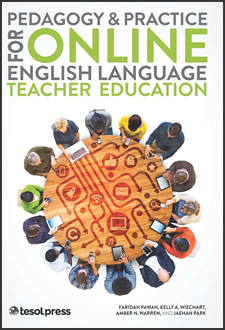Free Chapter From Pedagogy and Practice for Online English Language Teacher Education
 Chapter 1: Teaching Presence in Online Teaching
Chapter 1: Teaching Presence in Online Teaching
by Faridah Pawan
From Pedagogy and Practice for Online English Language Teacher Education (Faridah Pawan, Kelly A. Wiechart, Amber N. Warren, and Jaehan Park)
[If we accept] successful teaching is a combination of intellectual commitment and embodied experience—that it is as much thought as it is action—then we need to advocate for the learning environment that allows both to play out.
—Lucia Volk, “Teach It Like You Mean It,” 2012, para 23
In the U.S. movie The Wizard of Oz, a teenager named Dorothy along with her dog, Toto, are carried by a tornado to the Land of Oz. The movie goes on to describe Dorothy’s quest to meet a well-known wizard to get his help to find her way home. She is accompanied by a group of three friends on her journey, namely the Scarecrow, the Tin Man, and the Lion. The Scarecrow wants the wizard to give him a brain so he can be intelligent; the Tin Man wants a heart so he can feel emotion; and the Lion wants courage so he can be brave. Although no one has ever seen the wizard, they are all convinced he has the power to help them. Part of their quest involves following a yellow brick road. The movie ends with Dorothy and her friends realizing that it is not the wizard himself but the knowledge of him being present that enables them to discover their own strengths and help themselves. This realization comes about when they find out that wizard is an ordinary man creatively using tools at his disposal to make things happen. In a way, the story of the Wizard of Oz represents the potential of presence to be a powerful guiding force to productive outcomes. However, there is careful planning and work behind the presence that makes it effective.
In this chapter, I discuss the theoretical conceptualization of teaching presence and provide examples of its implementation from an online graduate program for new and in-service teachers of English as a second language (ESL).
Presence Theory
Presence as a theoretical concept emerged from social presence and teacher immediacy research (Lowenthal & Parscal, 2008). Social presence is defined by Short, Williams, and Christie (1976) as the “saliency” or mutual noticeability of interlocutors, or communicators, and the consequences of that noticeability. The medium of communication is central to this conceptualization of saliency in that it determines the nature of the presence (Lowenthal & Parscal, 2008). For example in video materials, there is both visual and audio presence whereas in audio-only materials there is only audio presence. Immediacy is another component of social presence, which in its positive sense, Mehrabian and Epstein (1972) define as linguistic and nonlinguistic communication that develops a sense of affinity between communicators. It is the ability to effectively project approachability, likeability, and interest in sustaining engagement into the communication situation while being aware of these attributes in others.
Saliency and immediacy thus constitute social presence in that it depends on interlocutors’ engagement with others around them. In this regard, social presence is “a complex and nuanced aspect of teaching” not a “checklist of behaviors, dispositions, measures, and standards” (Rogers & Raider-Roth, 2006, p. 265) as it is often simplistically regarded in an education climate of quantifiable accountability. Social presence thus requires teachers’ critical self-awareness and capability to develop relationships and construct safe and trusting environments so that learning can take place. Thus, this conceptualization of social presence can be seen as foundational to the concept of presence in teaching, which according to Rogers & Raider-Roth, 2006, p. 267) has three aspects: connection to self, connection to students, and connection to subject matter and pedagogical knowledge. Each of these aspects is described below.
TESOL Blogs
Interested in writing a blog for TESOL?
Read the submission guidelines and send us your post!
Check out some of the most recent TESOL Blogs:
|
3 Speaking Skills for the First Day of Class: Hit the Ground Running, by A. C. Kemp

For many of us, the first day of school is fast approaching. The first class is crucial because it sets the tone for the rest of the semester. Therefore, we focus on creating a friendly, low-stress environment, setting clear expectations, and building community through introduction activities.
One thing we don’t always do is teach new skills on the first day. However, doing so can add another dimension to the class and give students a feeling of accomplishment right off the bat.
Following are three examples of how speaking skills can be built into introduction activities that you may already be doing: The Name Game (vocabulary), Twist and Shout (tag questions), and In Common (question intonation). Read more. |
|
7 Virtual and Face-to-Face Activities for the First Week of School, by Judie Haynes

As we go back to school this fall, many teachers are faced with changing school policies because of the COVID-19 pandemic. School districts that originally planned to go back full time to their brick-and-mortar buildings may have to change their plans at the last minute depending on the COVID-19 statistics in their state. Many teachers are planning for both face-to-face and virtual classrooms because their districts are implementing a hybrid model.
I think teaching during a pandemic is the biggest challenge modern teachers have ever faced. Many teachers will be meeting their students for the first time in a virtual classroom. Getting to know students is a necessary step for all teachers in setting up a safe and caring environment, whether it is virtual or face-to-face. Read more. |
|
Making Discussion Boards More Engaging, by Betsy Gilliland
 With the world’s education systems shifting to online instruction as the COVID-19 pandemic continues into a new academic year, teachers need to think carefully about how we can maintain the interactive features we value in face-to-face classes without endangering our students’ health. Most learning management systems (LMSs) have some form of discussion board tool that allows students to post something they have written and reply to their classmates’ posts. Depending on the LMS, these may be simple text boxes where students can only write words, or they may have more functionality and allow students to share links and images as well. With the world’s education systems shifting to online instruction as the COVID-19 pandemic continues into a new academic year, teachers need to think carefully about how we can maintain the interactive features we value in face-to-face classes without endangering our students’ health. Most learning management systems (LMSs) have some form of discussion board tool that allows students to post something they have written and reply to their classmates’ posts. Depending on the LMS, these may be simple text boxes where students can only write words, or they may have more functionality and allow students to share links and images as well.
Discussion boards are useful because they make it possible to have asynchronous interaction in an online format. Students can work on their own time but also see their classmates’ ideas and collaborate. With social distancing required in classrooms, this format can be more personal than sitting 6 feet away and shouting through masks during an attempt at face-to-face discussion. Students can also make use of internet resources to support their writing. Read more. |